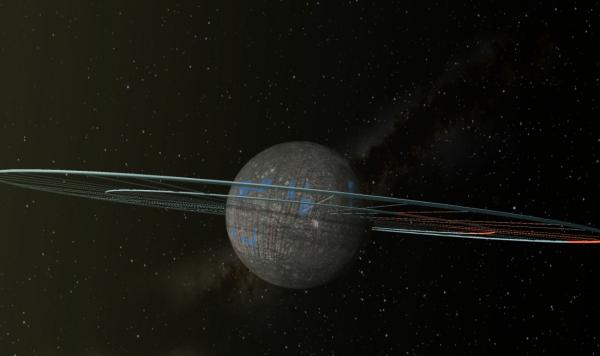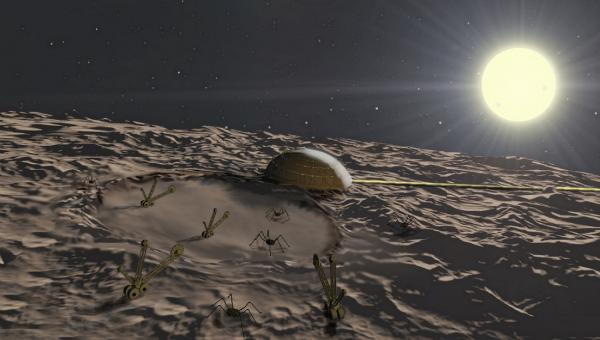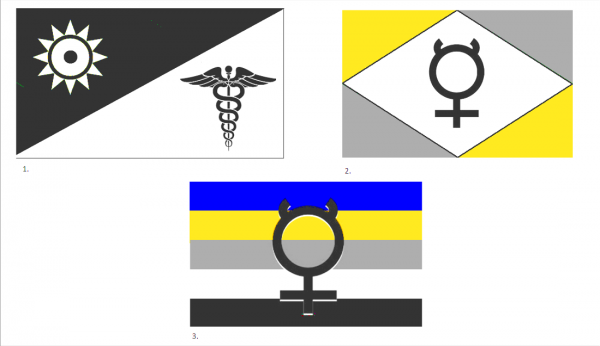BY LETTER
Mercury
Galactography > Regions of Space > Inner Sphere
Galactography > Other Major Polities, Empires, and Meta-Empires > Solsys Organization
Galactography > Other Major Polities, Empires, and Meta-Empires > Solsys Organization
Hot, resource-rich world in the Old Solar System. | |
 Image from Steve Bowers | |
| Mercury in the Current Era is surrounded by two large orbital ring structures, with numerous elevators extending to the surface. These rings are home to billions of virtual sophonts, and play vital roles in transport and heat management. | |
Mercury Data Panel | |
| System: | Solsys |
|---|---|
| Primary: | Sol |
| Planet: | Mercury (Sol I) |
| Planet Type: | Small, rocky world, Hermian type. This world has a large, molten core heated by tidal flexing and primordial radioactivity. |
| Distance from Primary: | orbits Sol at a mean distance of 0.387 AU. |
| Radius: | 2439 km |
| Density: | 5.44 gm/cm3 |
| Gravity: | 0.378 gee |
| Day | 59 days |
| Year | 88 days |
| Axial Tilt: | 7 degrees |
| Satellites: | none |
| Atmosphere: | Mercury originally had negligible atmosphere |
| Average Surface Temperature: | between 350°C and -170°C. |
| AI | AI overseers: The Lares |
| Polity | Name: Mercury Administration (Umbrella Body) Symbol: The Mercury Administration Flag. Affiliation: The Solsys Organization / Fomalhaut Acquisition Society. First manned landing: 129 AT |
| Territory and Population | Population: 36 billion sophonts (64% sophtwares, 18% vecs, 4% Martian tweaks, 3% superiors, 2% cyborgs, 9% other). Most of the embodied population live in the subterranean levels, while the Sophtware population mostly live on the orbital structures Caduceus Alpha and Caduceus Beta. A small but influential number of Sun Miners maintain holiday homes on the outer shell. Territory: Mercury and Cis-Mercurian space; the intra-mercurial bands are considered protectorates but have complete autonomy. |
| Government and Administration | Government: Mercury Administration, democratic council overseen by the S1 entities known as the Lares; composed of 86 sub-polities, many with considerable autonomy; member of the Solsys Organization, with close ties to the Fomalhaut Acquisition Society. |
| Economics and Local Infrastructure | Currency: Osmium standard, Solar credit Major Industries: tourism, helioanakalyptics, arts and crafts, pilgrimage Angelnetting: in some locations |
| Travel | Major Spaceports:. Surface: Mercury Interplanetary, also many smaller ones Orbital structures: Caduceus Alpha orbital ring, Caduceus Beta orbital ring, Helios Major spaceport; Clarke Docks; numerous smaller stations Hazard Rating : orbitals 0.0 to 0.2 planet 0.0 to 2.5 (Mercury has severe space weather on occasion) Visa Restrictions: Two to three month waiting period for a surface visa (this period can be considerably shortened if one has the right contacts and/or can find a bribeable official Freedom of Movement: Some habitats not accessible to bionts Environmental Requirements: Vacuum suit (with temperature control) required for non-biont areas Sites of Interest: Still based on Mercury are a number of ancient solar observatories, most of them robot outposts. Although the ais inhabiting them still continue the original duty of the forecasting of solar flares, for the most part they seem more interested in aesthetic contemplation of the endless variations of solar activity. These outposts are also a popular spot with Sun Miners, who have a friendly sim art and cultural exchange relationship with the virtuals. |
 Image from The Astronomer | |
| Mercury at the start of the Solsys Era, before mining operations commenced | |
Mercury is a world rich in history. The first crewed landing was in 2098 c.e. (129 A.T.) by a multinational mission from Earth. This fast-moving world is isolated from the rest of the Solar System by the largest delta-vee requirements of any journey from elsewhere in Solsys to its surface; so after the first landing there was a long period when further missions were infrequent. However Mercury has abundant solar power and a wealth of minerals to exploit, so an increasing number of mining concerns became established there during the Interplanetary Age.
By the end of this period Mercury was the base for a number of amat corporations, which converted solar power into antimatter. The largest of the several facilities at Mercury was an Exodynamics mining and fabrication operation producing solar panels. These were used in amat farms in near-solar orbit to produce kilogram quantities of antimatter per year. There were also extensive mining industries extracting the heavy siderophile elements such as osmium and platinum which were found in greater abundance on Mercury than anywhere else in the Solar System, often at very great depths. Because of this Mercury has many deep tunnels and huge subterranean pits which were excavated by explosive charges and energy beams in order to expose the mineral-bearing layers.
 Image from Steve Bowers | |
| Subverted mining machines approach the Exa Energy Base dome habitat on Mercury, at the start of the Technocalypse Event | |
A large number of habitats were destroyed during the Technocalypse, when a significant fraction of the neumann systems involved in mining were subverted and attacked at random. The Joh-Lau culture managed to avoid this destruction, and survived through the entire Solsys Dark Ages, but after achieving great cultural heights had declined to a few savage remnants by the time it was discovered in the late 900's.
After the Dark Age
During the First Federation Era Mercury was once again the center of the amat corporations, and the population became concentrated in the so-called capital Caloris City, which was built on the site of the old (pre-Technocalypse) Pittsburgh Dva, a US-Russian mining colony. Other population centres included Helio Arcology, Scarp City (with a large vec contingent at that time), Petrarch, and Big Heat. At the surface these cities included numerous domed habitats with highly reflective outer skins for reasons of thermal management. Most of the population lived in underground tunnels and converted mines. The surface was covered in dark solar power collectors which doubled as radiators at night.Mercury remained a major centre for amat production during the early First Federation era, but after the development of the conversion drive, the industry stagnated and much of the planet was abandoned to vecs and some squatting tweak clans. Vast empty caverns remained underground where mining operations had removed minerals for off-world construction projects.
In 2650 AT an experimental nanecology went feral on Mercury, leading to an infestation of autoevolving nanobots which caused major concern. The Second Federation began a long and costly clean-up, restoring Mercury to something approximating its former state. Currently it has become something of a traditional in-spot for Sun Miners; although Sun Mining is not permitted in this system, many Sun Miners trace their ancestry back to the first waves of Mercurian colonisation and come here to visit the historical sites.
The Helios Orbital Bands, important solar power collection structures in orbit around the Sun within Mercury's orbit, were mostly built from material exported from Mercury's surface. Closer to the Sun still are several layers of connected superobjects constructed by the goddess GAIA Herself for her own energy needs and for data processing; these objects have been constructed from material lifted directly from the star.
During the ComEmp Era the Fomalhaut Acquisition Society invested heavily in the tourist trade on this world, opening numerous luxury hotels and other accommodations, and opening up the deeper caverns. More investment came from local Sun Miners, who often kept holiday homes on the surface. The Solsys Org viewed these developments with some suspicion and questioned the motives of the Fomacs. However the economy of Mercury gained many benefits from this investment and the planet was gradually redeveloped into a Type I Shell World.
Mercury in the Current Era
Planetary Surface: Starting in the Age of New Empires, five concentric habitable layers have been established in Mercury's crust. Each layer has a separate atmosphere with airwalls used to prevent mixing and pressure equalisation; the chambers below ground are lined with thick diamondoid, while the upper layers are supported by thick columns of similar materials. Image from Steve Bowers | |
| A self-luminous lake in Bism, the deepest carvern level on Mercury, with the city of Stalactitopolis suspended above it. | |
Above Bism is Khazad-dum, a series of unlit, regular caverns connected in a geometric pattern; the roof is no more than 900m high. These caverns contain a largely empty, dark, urban landscape. The city is continually being rebuilt by the inhabitants, who are mostly vecs of various kinds. Some buildings are left untouched and are thousands of years old, but most have been reconstructed over and over again. The city holds many small communities of bionts of various kinds, in well-lit enclaves surrounded by innumerable dark structures.
Above this is Wotum, a rolling agricultural level with a cheerful blue sky. Optical phased arrays in the ceiling give the illusion of natural weather. Artificial rain supplies the fields below with water; these fields grow a range of traditional and geneered food crops, as well as biotech products such as biocomps, bioforge cores and nanotrees.
The level known as Elderdasht is built on the original planetary surface. The ancient habitats of Caloris City, Helio Arcology, Scarp City, Petrarch, and Big Heat are still in situ, but they are now immersed in an Earth-like atmosphere. The rest of this layer has been returned to its original state, with craters, boulders and regolith. A significant number of Mercurians live deep in this desert beneath a mildly enhanced Mercurian sky.
Suspended above the original surface is a continuous layer known as Undervale, which has been pressurised to resemble the original Martian atmosphere. Martian tweaks and other low-pressure clades make up the bulk of the population here.
Above this is a shell designed to resemble the original planetary surface as it appeared in the First Federation Era, complete with mining scars and solar power arrays. This layer supports a number of inhabited mega-mechas and walking cities, many of which attempt to stay at a given position relative to the slowly moving Sun in the sky. At the equator a moving city only needs to maintain an average speed of 5.8 kph, although this speed must change somewhat at different times in Mercury's eccentric orbit. The largest moving structure is the Night Serpent, actually several habitats connected by (and to) a mobile Lofstrom loop.
Orbital Space: Mercury cannot use normal space elevators, because its rate of rotation is far too slow. Instead there are two massive orbital rings known as Caduceus Alpha and Caduceus Beta. These are located at altitudes of 10,000 and 20,000 km and are connected to the surface by many pendant elevators. Caduceus Alpha and Beta are home to billions of virtual sophonts and other infomorphs, and act as transport hubs (and as cooling radiators when in shadow).
Further out from Mercury are the independently orbiting habitats and power collectors of the Helios Band, including Helios Major and Clarke Docks, bustling hubs of activity and host to large numbers of interplanetary and interstellar craft. Larunda Platform is an open-frame microgravity structure designed for the use of space-adapted vecs. The Helios Band includes many minor computronium nodes running virtual cybercosms, boost-beam stations and heritage antimatter farms.
 Image from MacGregor | |
| 1: Pre-Technocalypse flag of the Mercury Development Zone (including the Alliance of Near-Solar Habitats). 2: Flag used by Mercury in the First Federation era. 3: Flag of the Mercury Administration, which blends elements of the previous two plus a blue stripe for the Solsys Organization. | |
Back to Solsys
Related Articles
Appears in Topics
Development Notes
Text by Anders Sandberg and M. Alan Kazlev, additional material by Todd Drashner
New material by MacGregor added 2017
Initially published on 02 August 2002.
'Helios A, B, & C orbitals' stub article merged into Mercury article / deleted for duplicated information, 2017
New material by MacGregor added 2017
Initially published on 02 August 2002.
'Helios A, B, & C orbitals' stub article merged into Mercury article / deleted for duplicated information, 2017






